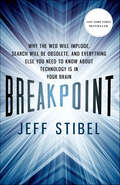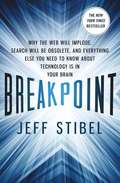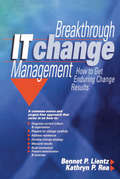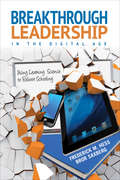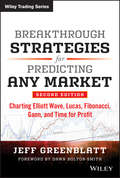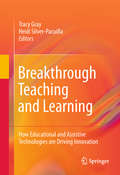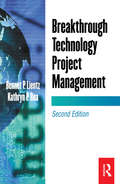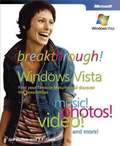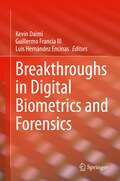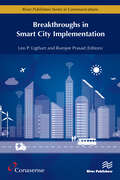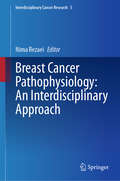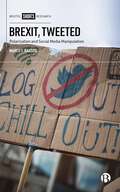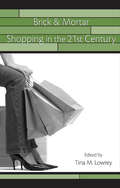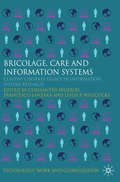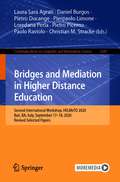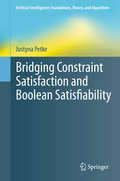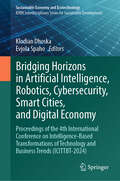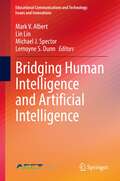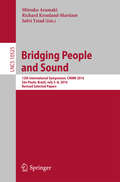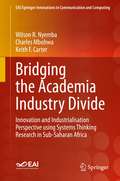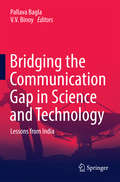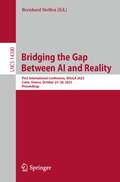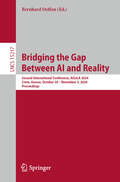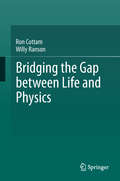- Table View
- List View
Breakpoint
by Jeff StibelWhat can the human brain and its relationship to the internet tell us about our society, our technologies, and our businesses? A lot, as it turns out. The internet today is a virtual replica of the brain, and the networks that leverage it grow and collapse in ways that are easily predictable if you understand the brain and other biological networks. We're living in the midst of a networking revolution. All of the major technology innovations of the 21st century – social networking, cloud computing, search engines, and crowdsourcing, to name a few – leverage the internet and are thus bound by the rules of networks. We've seen the exponential growth of these technologies, and they've led to a more efficient and tightly connected world. But what many people don't realize is that all networks eventually reach a breakpoint and collapse. This happens in the brain, it happens in nature, it happened to MySpace, and it will happen to Facebook and Google. It is critical to understand where the breakpoint is in the networks you use in order to achieve optimum success. Navigating the world of new technologies today can be like walking through a minefield unless you know the path. Imagine what you could do with a roadmap for where things are headed? In this fascinating look at the future of business and technology, neuroscientist and entrepreneur Jeff Stibel shows how the brain can act as a guide to understanding the future of the internet and the constellation of businesses and technologies that run on it. He'll show how leaders like Marissa Mayer are using artificial intelligence to literally remake Yahoo! and how startups like oDesk and Kickstarter are using crowdsourcing, the next wave of revolutionary technology, to create something much larger and "smarter" than the sum of their parts. Stibel offers a fresh perspective about the future of business and technology in a candid and engaging manner.
Breakpoint: Why The Web Will Implode, Search Will Be Obsolete, and Everything Else You Need To Know About Technology Is In Your Brain
by Jeff StibelWhat can the human brain and its relationship to the internet tell us about our society, our technologies, and our businesses? A lot, as it turns out. The internet today is a virtual replica of the brain, and the networks that leverage it grow and collapse in ways that are easily predictable if you understand the brain and other biological networks. We're living in the midst of a networking revolution. All of the major technology innovations of the 21st century - social networking, cloud computing, search engines, and crowdsourcing, to name a few - leverage the internet and are thus bound by the rules of networks. We've seen the exponential growth of these technologies, and they've led to a more efficient and tightly connected world. But what many people don't realize is that all networks eventually reach a breakpoint and collapse. This happens in the brain, it happens in nature, it happened to MySpace, and it will happen to Facebook and Google. It is critical to understand where the breakpoint is in the networks you use in order to achieve optimum success. Navigating the world of new technologies today can be like walking through a minefield unless you know the path. Imagine what you could do with a roadmap for where things are headed? In this fascinating look at the future of business and technology, neuroscientist and entrepreneur Jeff Stibel shows how the brain can act as a guide to understanding the future of the internet and the constellation of businesses and technologies that run on it. He'll show how leaders like Marissa Mayer are using artificial intelligence to literally remake Yahoo! and how startups like oDesk and Kickstarter are using crowdsourcing, the next wave of revolutionary technology, to create something much larger and "smarter" than the sum of their parts. Stibel offers a fresh perspective about the future of business and technology in a candid and engaging manner.
Breakthrough IT Change Management
by Bennet Lientz Kathryn ReaThis is a *different* book on change management. Using commonsense and practical advice tested in their work with hundreds of organizations, the authors walk the reader through clear guidelines and checklists to implement change that works. Readers will develop a change management strategythat starts by diagnosing the current culture and organization, then prepares for change carefully, addresses resistance to change, develops the change strategy, measures results, builds momentum for further change, and prevents deterioration and reversion. The authors then apply their framework to two areas that are major targets for change management: implementing new technology and systems and implementing successful e-business strategies. Included throughout are real-world examples from a number of industries and government.
Breakthrough Leadership in the Digital Age: Using Learning Science to Reboot Schooling
by Frederick M. Hess Dr Bror V. SaxbergReboot student learning the right way! Today’s most successful school leaders are truly “learning engineers”: creative thinkers who redefine their problems and design new ways to better serve kids’ success. Technology has a critical role, but it’s the creative reinvention of schools, systems, and classrooms that has to come first. In this powerful book, best-selling author and education policy expert Rick Hess and chief learning officer Bror Saxberg show you how to become your school's learning engineer. Using cutting-edge research about learning science as a framework, you’ll: Identify specific learning problems that need solving Devise smarter ways to address them Implement technology-enabled, not technology-driven, solutions
Breakthrough Strategies for Predicting Any Market: Charting Elliott Wave, Lucas, Fibonacci, Gann, and Time for Profit (Wiley Trading #53)
by Jeff GreenblattThe revised and updated edition of the book that changed the way you think about trading In the Second Edition of this groundbreaking book by star trader Jeff Greenblatt, he continues to shares his hard-won lessons on what it takes to be a professional trader, while detailing his proven techniques for mastering market timing. With the help of numerous case studies and charts, Greenblatt develops his original high-probability pattern recognition system which, once mastered, endows its user with a deeper understanding of how the markets really work and boosts the efficiency of any trading methodology. Following in the footsteps of the great W.D. Gann, Jeff Greenblatt helps investors gain greater precision with any instrument they trade, during any time frame. Shows how to combine a variety of technical indicators to pinpoint turning points in the financial markets Makes even the most complex subject matter easy to understand with crystal-clear explanations and step-by-step guidance on all concepts, terms, processes, and techniques Reveals how to use Elliott Wave Analysis, Fibonacci, candlesticks, and momentum indicators to interpret market movements Breakthrough Strategies for Predicting Any Market shares fascinating and enlightening personal anecdotes from Jeff Greenblatt's career along with his candid reflection on developing and maintaining the mental discipline of a successful trader.
Breakthrough Teaching and Learning: How Educational and Assistive Technologies are Driving Innovation
by Tracy Gray Heidi Silver-PacuillaThe many technology-related educational changes of the past decade have been propelled by even greater changes in the general consumer technology landscape. Education has become increasingly entwined with the digital consumer landscape. We are no longer asking whether digital materials and tools should be integrated into teaching and learning, but how and how well. Meanwhile, the overall academic performance of U.S. students has not kept pace with our international peers. Many policymakers have called for increased attention to students' 21st century skills and work readiness, pointing to the critical role technology should play in educational innovation. These changes mean that many mainstream accessible technologies can be used in the classroom to benefit a diverse population of learners, including students with disabilities and English language learners, reflecting the national shift from separate special education programs to more inclusive classrooms. Changes to policies and standards have pushed assistive and accessible technologies to the forefront, including the Higher Education Opportunity Act of 2008, which requires teacher preparation programs to address educational technology and principles of universal design for learning (UDL), and the National Instructional Materials Accessibility Standard (NIMAS), which creates a public-private infrastructure to provide more timely delivery of digital text to students with physical and print disabilities. This volume represents pioneering ideas that examine how accessible educational technologies can be harnessed for breakthrough learning for all students. Chapters will cover innovation trends in educational and assistive technologies, cognitive and neuroscience findings on how individual differences impact technology use and choice; the intersection of educational, leisure, health habits and exer-gaming; the use of social networking tools by students with and without disabilities; the use of social networking for teacher professional learning communities; the future of assessments for decision-making; and an analysis of the habits of mind and work traits of innovators NCTI has interviewed over the past five years.
Breakthrough Technology Project Management
by Bennet Lientz Kathryn ReaAlthough there are many books of methods and tools in different areas, few books actually give detailed tips and lessons on how to effectively set up and manage projects. Most books on project management devote all their space to specific methods. Breakthrough Technology Project Management, Second Edition provides tangible guidelines through examples and suggestions to help people participate in and manage projects more effectively. The authors' techniques and guidelines have been proven over the past 15 years in courses and counseling. This book is a valuable tool for those working in information systems, engineering, computer science, operations and production, and other environments involving project management.
Breakthrough Windows Vista™: Find Your Favorite Features and Discover the Possibilities
by Joli Ballew S. E. SlackSpark your imagination! Go on new adventures! Find a new hobby! Now that you have Windows Vista, it's time to experience all that it has to offer. And, you'll have fun along the way. Choose from dozens of cool projects and discover the amazing things you can do with your PC in this full-color guide. No need to read from cover to cover. Just pick the topics that interest you most--then jump in and start exploring your favorite features. Discover the possibilities! Transform your snapshots into the ultimate photo library Be your own DJ--rip it, burn it, stream it, take it on the go! Action! Produce your own movie, video blog, or podcast Use e-mail, online journals, and slideshows to share your digital masterpieces Watch, pause, and rewind live TV--and record your favorite shows Find new ways to access the information you need: Sidebar, Gadgets, Instant Search
Breakthroughs in Digital Biometrics and Forensics
by Luis Hernández Encinas Kevin Daimi Guillermo FranciaThis book focuses on a wide range of breakthroughs related to digital biometrics and forensics. The authors introduce the concepts, techniques, methods, approaches and trends needed by cybersecurity specialists and educators for keeping current their biometrics and forensics knowledge. Furthermore, the book provides a glimpse of future directions where biometrics and forensics techniques, policies, applications, and theories are headed. Topics include multimodal biometrics, soft biometrics, mobile biometrics, vehicle biometrics, vehicle forensics, integrity verification of digital content, people identification, biometric-based cybercrime investigation, among others. The book is a rich collection of carefully selected and reviewed manuscripts written by diverse digital biometrics and forensics experts in the listed fields and edited by prominent biometrics and forensics researchers and specialists.
Breakthroughs in Smart City Implementation (River Publishers Series In Communications Ser.)
by Ramjee Prasad Leo P. LigthartBreakthroughs in Smart City Implementation should give answers on a wide variety of present social, political and technological problems. Green and long-lasting solutions are needed in coming 10 years and beyond on areas as green and long lasting solutions for improving air quality, quality of life of residents in cities, traffic congestions and many more.Two Conasense branches, established in China and in India, report in six book chapters on initiatives needed to overcome the obvious shortcomings at present. Three more chapters complete this fifth Conasense book: an introductory chapter concerning Smart City from Conasense perspective, a chapter showing that not technology but the people in the cities are most important and a chapter on recent results and prospects of “Human in the Loop” in smart vehicular systems.
Breast Cancer Pathophysiology: An Interdisciplinary Approach (Interdisciplinary Cancer Research #5)
by Nima RezaeiBreast cancer is one of the most prevalent malignancies worldwide, particularly in females, with a high rate of cancer-related deaths globally. Increasing age, obesity, harmful use of alcohol, family history of breast cancer, starting age of menstrual periods, and tobacco use are some of the risk factors for breast cancer. The fifth volume of the “Interdisciplinary Cancer Research” series, entitled “Breast Cancer Pathophysiology: An Interdisciplinary Approach” publishes comprehensive volumes on the mechanisms of breast cancer, early detection, assessment, and patient outcome. The role of defective estrogen signals, membrane estrogen receptor, and dietary polyunsaturated fatty acids in breast cancer are also presented in this volume. This interdisciplinary series is of special value to researchers working on cell biology, immunology, biochemistry, genetics, and practitioners working on oncology. This is the main concept of Cancer Immunology Project (CIP), which is a part of Universal Scientific Education and Research Network (USERN). This interdisciplinary book will be of special value to researchers, oncologists, and oncosurgeons who wish to extend their knowledge on breast cancer.
Brexit, Tweeted: Polarization and Social Media Manipulation
by Marco BastosDissecting 45 million tweets from the period that followed the Brexit referendum, this book presents an extensive analysis of social media manipulation. The book examines emerging changes in partisan politics, nationalist and populist values, as well as broader societal changes that are feeding into polarization and echo-chamber communication. It pulls the curtain back on the techniques employed to interfere with, and potentially distort, the public discussion. Making complex data accessible to non-technical audiences, this unique post-mortem of the Brexit referendum contributes to our understanding of social media disinformation in the UK and beyond.
Brick & Mortar Shopping in the 21st Century
by Tina M. LowreyThis book explores how traditional retailing operates in the new competitive environment of a combined e-tailing and brick and mortar marketplace. In drawing together the cutting-edge research of a global group of experts in the field of consumer behavior, this volume addresses questions such as: which psychological theories can provide insights in
Bricolage, Care and Information: Claudio Ciborra's Legacy in Information Systems Research (Technology, Work and Globalization)
by Giovan Francesco Lanzara Leslie P. Willcocks Chrisanthi AvgerouClaudio Ciborra was one of the most innovative thinkers in the field of information systems. This book explains the intellectual contribution of Ciborra's work in a substantial introductory chapter, contains the most significant of his articles, and provides a sample of research that draws from his ideas.
Bridges and Mediation in Higher Distance Education: Second International Workshop, HELMeTO 2020, Bari, BA, Italy, September 17–18, 2020, Revised Selected Papers (Communications in Computer and Information Science #1344)
by Daniel Burgos Pietro Ducange Pietro Picerno Paolo Raviolo Christian M. Stracke Laura Sara Agrati Pierpaolo Limone Loredana PerlaThis book constitutes the thoroughly refereed post-conference proceedings of the Second International Workshop on Higher Education Learning Methodologies and Technologies Online, HELMeTO 2020, held in Bari, Italy, September 2020. Due to the COVID-19 pandemic the conference was held online. The 25 revised full papers and 3 short papers presented were carefully reviewed and selected from a total of 59 submissions. The papers present recent research on challenges of implementing emerging technology solution for online, online learning pedagogical frameworks, facing COVID19 emergency in higher education teaching and learning, online learning technologies in practice, online learning strategies and resources, etc.
Bridging Constraint Satisfaction and Boolean Satisfiability (Artificial Intelligence: Foundations, Theory, and Algorithms)
by Justyna PetkeThis book provides a significant step towards bridging the areas of Boolean satisfiability and constraint satisfaction by answering the question why SAT-solvers are efficient on certain classes of CSP instances which are hard to solve for standard constraint solvers. The author also gives theoretical reasons for choosing a particular SAT encoding for several important classes of CSP instances. Boolean satisfiability and constraint satisfaction emerged independently as new fields of computer science, and different solving techniques have become standard for problem solving in the two areas. Even though any propositional formula (SAT) can be viewed as an instance of the general constraint satisfaction problem (CSP), the implications of this connection have only been studied in the last few years. The book will be useful for researchers and graduate students in artificial intelligence and theoretical computer science.
Bridging Horizons in Artificial Intelligence, Robotics, Cybersecurity, Smart Cities, and Digital Economy: Proceedings of the 4th International Conference on Intelligence-Based Transformations of Technology and Business Trends (ICITTBT-2024) (Sustainable Economy and Ecotechnology)
by Evjola Spaho Klodian DhoskaThis book aims to foster interdisciplinary research among industry and academic participants and form long-term strategic links. It provides a presentation of new knowledge and development through the exchange of practical experience between industry, scientific institutes and business. The carefully selected conference themes have been chosen to engender these in the fields of engineering, industry, information technology, business, economics and finance, and applied sciences. This book aims to provide the latest research findings, innovative research results, methods and development techniques from both theoretical and practical perspectives related to the emerging areas of artificial intelligence, cybersecurity, robotics and automation, smart technologies, data analytics and data science, network and communication, cloud and mobile computing, Internet of things, virtual augmented and mixed reality, technology in applied science, digital economy, management and business, finance and accounting, statistics and econometrics, economics and social sciences.
Bridging Human Intelligence and Artificial Intelligence (Educational Communications and Technology: Issues and Innovations)
by Lin Lin Michael J. Spector Mark V. Albert Lemoyne S. DunnThis edited volume is based on contributions from the TCET-AECT “Human-Technology Frontier: Understanding the Learning of Now to Prepare for the Work of the Future Symposium” held in Denton, Texas on May 16-18, sponsored by AECT. The authors embrace an integrative approach to designing and implementing advances technologies in learning and instruction, and focus on the emerging themes of artificial intelligence, human-computer interactions, and the resulting instructional design. The volume will be divided into four parts: (1) Trends and future in learning and learning technologies expected in the next 10 years; (2) Technologies likely to have a significant impact on learning in the next 10 years; (3) Challenges that will need to be addressed and resolved in order to achieve significant and sustained improvement in learning; and (4) Reflections and insights from the Symposium that should be pursued and that can form the basis for productive research collaborations. The primary audience for this volume is academics and researchers in disciplines such as artificial intelligence, cognitive science, computer science, educational psychology, instructional design, human-computer interactions, information science, library science, and technology integration.
Bridging People and Sound: 12th International Symposium, CMMR 2016, São Paulo, Brazil, July 5–8, 2016, Revised Selected Papers (Lecture Notes in Computer Science #10525)
by Mitsuko Aramaki Richard Kronland-Martinet Sølvi YstadThis book constitutes the thoroughly refereed post-conference of the 12th International Symposium on Computer Music Modeling and Retrieval, CMMR 2016, held in S#65533;o Paulo, Brazil, in July 2016. The 22 full papers presented were carefully reviewed and selected from 40 submissions. This year's conference theme "Bridging People and Sound" aimed at encouraging contributions from artists and listeners on the one side and audio and music technology researchers on the other.
Bridging the Academia Industry Divide: Innovation and Industrialisation Perspective using Systems Thinking Research in Sub-Saharan Africa (EAI/Springer Innovations in Communication and Computing)
by Charles Mbohwa Wilson R. Nyemba Keith F. CarterThis book is the result of years of research following a realization of the mismatch of engineering skills produced by universities and those that industry required, based on the situation in Sub-Saharan Africa, equally applicable to other regions in Africa and indeed worldwide. The book is meant to assist engineering academics and engineers in industry to build capacity and cope with the dynamic trends in technology brought on by the 4th Industrial Revolution and to prepare for the 5th Industrial Revolution, an era predicted to be dominated by critical and system thinkers with creative and innovative skills as basic necessities. The book is also useful for policy-making researchers in academia, industrial and public sector researchers, and implementers in governments that provide required funding for the development of human resources and skills. The book primarily consists of the novel research and innovation approaches of modelling and building systems thinking sub-models which were ultimately integrated into the Universal Systems Thinking (UST) model aimed at improving the quality of engineers and engineering practice. The initiatives in this book include strategies for bridging the gap between industry and academia through systems thinking research. The book provides information on how to model, simulate, adjust and implement integrated systems thinking approaches to engineering education and training for capacity building and sustainability. The book also covers approaches to address research gaps and mismatch of skills while capitalizing on the successes of several projects carried out and supported by the Royal Academy of Engineering over the years.
Bridging the Communication Gap in Science and Technology: Lessons from India
by Pallava Bagla V. V. BinoyThis first-of-a-kind volume provides a snapshot of existing science communication policy and practice in India across different S&T sectors, and offers solutions to building effective communication. It provides an understanding on how to avoid societal clashes in situations when science meets the public in these sectors. The editors and contributors argue that effective S&T communication leads not only to a more informed public but also benefits research itself, and in a changing society like India this is a crucial element related to good governance and policy making. In this volume, experienced masters of the craft provide practical solutions to making S&T communication more effective in a vast democracy like India, which has complex issues related to literacy levels, diverse languages, varying political will, reach, and resources. Through, discussions on cases of creating information modules for the public on the Internet, television and radio, social media, as well as traditional ways of outreach like people's science movements, holding popular science events, and fairs, the volume provides highly valuable directions on how developing countries with low resources and complex populations can communicate S&T research to the public and bridge communication gaps. This volume will interest researchers from science, social science, mass communication and public relations departments, journalists, as well as practitioners and policy makers from government and non-government institutions involved in S&T policy, practice and communication and people who want to understand the complex S&T landscape of India.
Bridging the Gap Between AI and Reality: First International Conference, AISoLA 2023, Crete, Greece, October 23–28, 2023, Proceedings (Lecture Notes in Computer Science #14380)
by Bernhard SteffenThis book constitutes the proceedings of the First International Conference on Bridging the Gap between AI and Reality, AISoLA 2023, which took place in Crete, Greece, in October 2023. The papers included in this book focus on the following topics: The nature of AI-based systems; ethical, economic and legal implications of AI-systems in practice; ways to make controlled use of AI via the various kinds of formal methods-based validation techniques; dedicated applications scenarios which may allow certain levels of assistance; and education in times of deep learning.
Bridging the Gap Between AI and Reality: First International Conference, AISoLA 2023, Crete, Greece, October 23–28, 2023, Selected Papers (Lecture Notes in Computer Science #14129)
by Bernhard SteffenThis open access book constitutes revised selected papers from the First International Conference on Bridging the Gap between AI and Reality, AISoLA 2023, which took place in Crete, Greece, in October 2023. The papers included in this book focus on the following topics: The nature of AI-based systems; ethical, economic and legal implications of AI-systems in practice; ways to make controlled use of AI via the various kinds of formal methods-based validation techniques; dedicated applications scenarios which may allow certain levels of assistance; and education in times of deep learning.
Bridging the Gap Between AI and Reality: Second International Conference, AISoLA 2024, Crete, Greece, October 30 – November 3, 2024, Proceedings (Lecture Notes in Computer Science #15217)
by Bernhard SteffenThis book constitutes the proceedings of the Second International Conference on Bridging the Gap between AI and Reality, AISoLA 2024, which took place in Crete, Greece, in October/November 2024. The papers included in this book focus on the following topics: AI assisted programming; digital humanities; approaches of using formal methods and ai in health care; models for trustworthy autonomous systems; responsible and trusted AI; safe autonomous vehicles; statistical model checking; verification and learning for assured autonomy; verification for neuro-symbolic artificial intelligence.
Bridging the Gap between Life and Physics
by Ron Cottam Willy RansonThis is the only book which deals with the correlatory comparison between hierarchical living systems and inorganic physical ones. The culmination of the book is the proposition of research to discover and understand the natural underlying level of organization which produces the descriptive commonality of life and physics. Traditional science eliminates life from its purview by its rejection of interrelationships as a primary content of systems. The conventional procedure of science is that of reductionism, whereby complex systems are dismantled to characterize lower level components, but virtually no attention is given to how to rebuild those systems—the underlying assumption is that analysis and synthesis are symmetrical. This book fulfills two main coupled functions. Firstly, it details hierarchy as the major formulation of natural complex systems and investigates the fundamental character of natural hierarchy as a widely transferable ‘container’ of structure and/or function – and this in the case of the new development of a representational or model hierarchy. Secondly, it couples this hierarchical description to that of the electronic properties of semiconductors, as a well-modeled canonical example of physical properties. The central thesis is that these two descriptions are comparable, if care is taken to treat logical and epistemological aspects with prudence: a large part of the book is composed of just this aspect of care for grounding consistency. As such great attention is given to correct assessment of argumentative features which are otherwise presumed ‘known’ but which are usually left uncertain. Development of the ideas is always based on a relationship between entity or phenomenon and their associated ecosystems, and this applies equally well to the consequent derivations of consciousness and information.
